Flexural Strength Design of Hybrid FRP-Steel Reinforced Concrete Beams
Abstract
:1. Introduction
- Failure mode I: FRP reinforcement ruptures after tensile steel reinforcement yielding without concrete crushing (lightly reinforced beam);
- Failure mode II: concrete crushing occurs after tensile steel reinforcement yielding without rupture of FRP reinforcement (moderately reinforced beam);
- Failure mode III: concrete crushing occurs while tensile steel and FRP reinforcement are in the elastic state (heavily reinforced beam).
2. Division of Flexural Failure Modes
2.1. Primary Hypotheses
- Strain varies linearly through the cross-section (that is, plane sections remain plane);
- Perfect bond exists between steel and FRP reinforcement and concrete;
- Concrete strain in compression is limited to 0.003, and under this condition the Whitney equivalent stress block is a valid substitution for nonlinear stress distribution;
- Stress-strain response of FRP reinforcement is linear-elastic up to failure;
- Steel reinforcement performs the ideal bilinear elastic-plastic behavior;
- Tensile strength of concrete is ignored.
2.2. Failure Mode I (FM-I)
2.3. Failure Mode II (FM-II)
2.4. Failure Mode III (FM-III)
3. Calculation of Flexural Strength
3.1. Failure Mode I
- Select a value of mechanical reinforcing index in the range of ;
- Assume a value of ;
- Calculate the parameters and using Equations (14) and (15);
- Determine the parameter on the basis of Equations (17) and (18), respectively, using the relevant data from steps 2 to 3;
- Check the values of estimated by Equations (17) and (18), respectively. If the values are identical, the relevant data from steps 2 to 4 are the required ones. If not, repeat steps 2 to 5 until they are identical.
3.2. Failure Mode II
3.3. Failure Mode III
4. Validation of Calculation Approach
5. Ductility Analysis and Strength Reduction Factor
5.1. Suggestions of Codes and Design Guidelines about Strength Reduction Factor
5.2. Ductility Index
5.3. Ductility Level and Strength Reduction Factor
6. Conclusions
- The design-oriented allowable ranges of reinforcement ratio corresponding to three common flexural failure modes of hybrid FRP-steel RC beams were specified according to the mechanical features of reinforcement and concrete and the latest codified provisions of longitudinal reinforcement conditions to guarantee the sufficient ductility level. For beams featured by the preferable flexural failure mode, the detailed relationship between net tensile steel strain level and reinforcement ratio was established to evaluate sectional ductility;
- The general calculation approach of nominal flexural strength was proposed for hybrid FRP-steel RC beams. In addition to the common moderately-reinforced beams, the approach was also applicable to lightly-reinforced beams and heavily-reinforced beams, which are widely used but rarely studied. Furthermore, the calculation process was simplified using the derived relationship between relative neutral axis depth and the reinforcement ratio, and the calculation accuracy was successfully validated by the experimental results. However, the stress block parameters are expected to be modified to consider the effect of FRP reinforcement ratio, and the proposed formulae for lightly-reinforced and heavily-reinforced beams need further verification and improvement due to rare experimental results;
- For hybrid FRP-steel RC beams featured by flexural failure modes II and III (i.e., moderately- and heavily-reinforced beams), the strength reduction factor can be used as that defined for conventional steel RC beams. For hybrid FRP-steel RC beam with failure mode I (i.e., lightly-reinforced concrete beams), the strength reduction factor was proposed in terms of different reinforcement ratios. It can be adopted as 0.55 and 0.9 for beams with the minimum reinforcement ratio and the balanced reinforcement ratio , respectively; and a linear transition for the strength reduction factor is assumed between the two critical reinforcement ratios;
- The proposed design methodology, based on the design philosophy and provisions of the relevant ACI codes, can be further modified and extended according to other design standards of practice.
Author Contributions
Funding
Institutional Review Board Statement
Informed Consent Statement
Data Availability Statement
Acknowledgments
Conflicts of Interest
References
- Aiello, M.A.; Ombres, L. Structural performances of concrete beams with hybrid (fiber-reinforced polymer-steel) reinforcements. J. Compos. Constr. 2002, 6, 133–140. [Google Scholar] [CrossRef]
- Leung, H.Y.; Balendran, R.V. Flexural behaviour of concrete beams internally reinforced with GFRP rods and steel rebars. Struct. Survey. 2003, 21, 146–157. [Google Scholar] [CrossRef]
- Nanni, A.; Luca, D.A.; Zadeh, H.J. Reinforced Concrete with FRP Bars: Mechanics and Design; CRC Press: New York, NY, USA, 2014. [Google Scholar]
- Zhou, B.; Wu, R.; Feng, J.; Yin, S. Modeling of tensile behavior of hybrid GFRP-steel reinforced concrete chords. Compos. Struct. 2019, 236, 1–10. [Google Scholar] [CrossRef]
- Qu, W.; Zhang, X.; Huang, H. Flexural behavior of concrete beams reinforced with hybrid (GFRP and steel) bars. J. Compos. Constr. 2009, 13, 350–359. [Google Scholar] [CrossRef]
- Yoon, Y.S.; Yang, J.M.; Min, K.H.; Shin, H.O. Flexural strength and deflection characteristics of high-strength concrete beams with hybrid FRP and steel bar reinforcement. ACI. Special. Publ. 2011, SP-275, 1–22. [Google Scholar]
- Safan, M.A. Flexural behavior and design of steel-GFRP reinforced concrete beams. ACI. Mater. J. 2013, 110, 677–685. [Google Scholar]
- Liu, Y.; Yuan, Y. Arrangement of hybrid rebars on flexural behavior of HSC beams. Compos. Part B. Eng. 2013, 45, 22–31. [Google Scholar]
- Ge, W.; Zhang, J.; Gao, D.; Tu, Y. Flexural behaviors of hybrid concrete beams reinforced with BFRP bars and steel bars. Constr. Build. Mater. 2015, 87, 28–37. [Google Scholar] [CrossRef]
- El Refai, A.; Abed, F.; Al-Rahmani, A. Structural performance and serviceability of concrete beams reinforced with hybrid (GFRP and steel) bars. Constr. Build. Mater. 2015, 96, 518–529. [Google Scholar] [CrossRef]
- Kara, I.F.; Ashour, A.F.; Köroğlu, M.A. Flexural behavior of hybrid FRP/steel reinforced concrete beams. Compos. Struct. 2015, 129, 111–121. [Google Scholar] [CrossRef]
- Zhou, B.; Wu, R.; Lu, S.; Yin, S. A general numerical model for predicting the flexural behavior of hybrid FRP-steel reinforced concrete beams. Eng. Struct. 2021, 239, 112293. [Google Scholar] [CrossRef]
- Bencardino, F.; Condello, A.; Ombres, L. Numerical and analytical modeling of concrete beams with steel, FRP and hybrid FRP-steel reinforcements. Compos. Struct. 2016, 140, 53–65. [Google Scholar] [CrossRef]
- Hawileh, R.A. Finite element modeling of reinforced concrete beams with a hybrid combination of steel and aramid reinforcement. Mater. Design. 2015, 65, 831–839. [Google Scholar] [CrossRef]
- Gu, X.; Dai, Y.; Jiang, J. Flexural behavior investigation of steel-GFRP hybrid-reinforced concrete beams based on experimental and numerical methods. Eng. Struct. 2020, 206, 110117. [Google Scholar]
- Araba, A.M.; Ashour, A.F. Flexural performance of hybrid GFRP-Steel reinforced concrete continuous beams. Compos. Part B. Eng. 2018, 154, 321–336. [Google Scholar] [CrossRef] [Green Version]
- Pang, L.; Qu, W.; Zhu, P.; Xu, J. Design propositions for hybrid FRP-steel reinforced concrete beams. J. Compos. Constr. 2015, 20, 04015086. [Google Scholar] [CrossRef]
- Linh, V.H.B.; Boonchai, S.; Ueda, T. Ductility of concrete beams reinforced with both fiber-reinforced polymer (FRP) and steel tension bars. J. Adv. Concr. Technol. 2018, 16, 531–548. [Google Scholar]
- Nguyen, P.D.; Vu, H.D.; Ngoc, A.V. Performance of concrete beams reinforced with various ratios of hybrid GFRP/steel bars. Civ. Eng. J. 2020, 6, 1652–1669. [Google Scholar] [CrossRef]
- Nguyen, P.D.; Dang, V.Q. Limiting reinforcement ratios for hybrid GFRP/steel reinforced concrete beams. Int. J. Eng. Technol. Innov. 2021, 11, 1–11. [Google Scholar] [CrossRef]
- Lau, D.; Pam, H.J. Experimental study of hybrid reinforced concrete beams. Eng. Struct. 2010, 32, 3857–3865. [Google Scholar] [CrossRef]
- Qin, R.; Zhou, A.; Lau, D. Effect of reinforcement ratio on the flexural performance of hybrid FRP reinforced concrete beams. Compos. Part B. Eng. 2017, 108, 200–209. [Google Scholar] [CrossRef]
- Ruan, X.; Lu, C.; Xu, K.; Xuan, G.; Ni, M. Flexural behavior and serviceability of concrete beams hybrid-reinforced with GFRP bars and steel bars. Compos. Struct. 2020, 235, 111772. [Google Scholar] [CrossRef]
- Yang, Y.; Pan, D.; Wu, G.; Cao, D.F. A new design method of the equivalent stress–strain relationship for hybrid (FRP bar and steel bar) reinforced concrete beams. Compos. Struct. 2021, 270, 114099. [Google Scholar] [CrossRef]
- Peng, F.; Xue, W. Analytical approach for flexural capacity of FRP prestressed concrete T-beams with non-prestressed steel bars. J. Compos. Constr. 2018, 22, 04018063. [Google Scholar] [CrossRef]
- Yost, J.; Gross, S.; Dinehart, D.; Mildenberg, J. Flexural behavior of concrete beams strengthened with near-surface-mounted CFRP strips. ACI. Struct. J. 2007, 104, 430–437. [Google Scholar]
- Hsu, T.T.C.; Mo, Y.L. Unified Theory of Concrete Structures; John Wiley and Sons: West Sussex, UK, 2010. [Google Scholar]
- Gilbert, R.; Smith, S. Strain localization and its impact on the ductility of reinforced concrete slabs containing welded wire reinforcement. Adv. Struct. Eng. 2006, 9, 117–127. [Google Scholar] [CrossRef]
- El-Mihilmy, M.T.; Tedesco, J.W. Analysis of reinforced concrete beams strengthened with FRP laminates. J. Struc. Eng. 2000, 126, 684–691. [Google Scholar] [CrossRef]
- Yost, J.R.; Steffen, R.E. Strength and ductility trends for concrete members strengthened in flexure with carbon fiber-reinforced polymer reinforcement. J. Compos. Construct. 2014, 18, 04014015. [Google Scholar] [CrossRef]
- Triantafillou, T.C.; Plevris, N. Strengthening of RC beams with epoxy bonded fibre composite materials. Mat. Struct. 1992, 25, 201–211. [Google Scholar] [CrossRef]
- Saqan, E.; Rasheed, H.; Hawileh, R. An efficient design procedure for flexural strengthening of RC beams based on ACI 440.2R-08. Compos. Part B. 2013, 49, 71–79. [Google Scholar] [CrossRef]
- ACI Committee 440. Guide for the Design and Construction of Externally Bonded FRP Systems for Strengthening Concrete Structures (440.2R-17); American Concrete Institute: Farmington Hills, MI, USA, 2017. [Google Scholar]
- ACI Committee 318. Building Code Requirements for Structural Concrete (ACI 318-19) and Commentary (ACI 318R-19); American Concrete Institute: Farmington Hills, MI, USA, 2019. [Google Scholar]
- ACI Committee 318. Building Code Requirements for Structural Concrete (ACI 318-14) and Commentary (ACI 318R-14); American Concrete Institute: Farmington Hills, MI, USA, 2014. [Google Scholar]
- ACI Committee 440. Guide for the Design and Construction of Structural Concrete Reinforced with Fiber-Reinforced Polymer (FRP) Bars (ACI 440.1R-15); American Concrete Institute: Farmington Hills, MI, USA, 2015. [Google Scholar]
- Todeschini, C.E.; Bianchini, A.C.; Kesler, C.E. Behavior of concrete columns reinforced with high strength steels. ACI J. Proc. 1964, 61, 701–716. [Google Scholar]
- Xue, W.; Peng, F.; Zheng, Q. Design equations for flexural capacity of concrete beams reinforced with glass fiber-reinforced polymer bars. J. Compos. Construct. 2016, 20, 4015–4069. [Google Scholar] [CrossRef]
- Nilson, A.H.; Darwin, D.; Dolan, C.W. Design of Concrete Structures; McGraw-Hill: New York, NY, USA, 2004. [Google Scholar]
- Yuan, F.; Wu, Y.F. Analytical method for derivation of stress block parameters for flexural design of FRP reinforced concrete members. Compos. Struct. 2019, 229, 111459. [Google Scholar] [CrossRef]
- Theriault, M.; Benmokrane, B. Effects of FRP reinforcement ratio and concrete strength on flexural behavior of concrete beams. J. Compos. Constr. 1998, 2, 7–16. [Google Scholar] [CrossRef]
- GangaRao, H.V.; Taly, N.; Vijay, P.V. Reinforced Concrete Design with FRP Composites; Taylor Francis Group: Abingdon, UK; CRC Press: Boca Raton, FL, USA, 2006. [Google Scholar]
- Shahrooz, B.M.; Reis, J.M.; Wells, E.L.; Miller, R.A.; Harries, K.A.; Russell, H.G. Flexural members with high-strength reinforcement: Behavior and code implications. J. Bridge. Eng. 2013, 19, 04014003. [Google Scholar] [CrossRef]
- Park, R.; Paulay, T. Reinforced Concrete Structures; Wiley: New York, NY, USA, 1975. [Google Scholar]
- Abdelrahman, A.A.; Tadros, G.; Rizkalla, S.H. Test model for the first Canadian smart highway bridge. ACI. Struct. J. 1995, 92, 451–458. [Google Scholar]
- Mast, R.F.; Dawood, M.; Rizkalla, S.H.; Zia, P. Flexural strength design of concrete beams reinforced with high-strength steel bars. ACI. Struct. J. 2008, 105, 570–577. [Google Scholar]
- Naaman, A.; Jeong, S. Structural ductility of concrete beams prestressed with FRP tendons, Non-metallic (FRP) reinforcements for concrete structures. Proc. Symp. 1995, FRPRCS-2, 379–386. [Google Scholar]
- Mufti, A.A.; Newhook, J.P.; Tadros, G. Deformability versus ductility in concrete beams with FRP reinforcement. In Advanced Composite Materials in Bridges and Structures; El-Badry, M., Ed.; Canadian Society of Civil Engineering: Montreal, QC, Canada, 1996; pp. 189–199. [Google Scholar]
- Mast, R.F. Unified Design Provisions for Reinforced and Prestressed Concrete Flexural and Compression Members. ACI. Struct. J. 1992, 89, 185–199. [Google Scholar]
- Zhou, B.; Wu, R.; Feng, J. Analytical model for rotation of singly reinforced flexural members. ACI. Struct. J. 2018, 115, 789–799. [Google Scholar] [CrossRef]

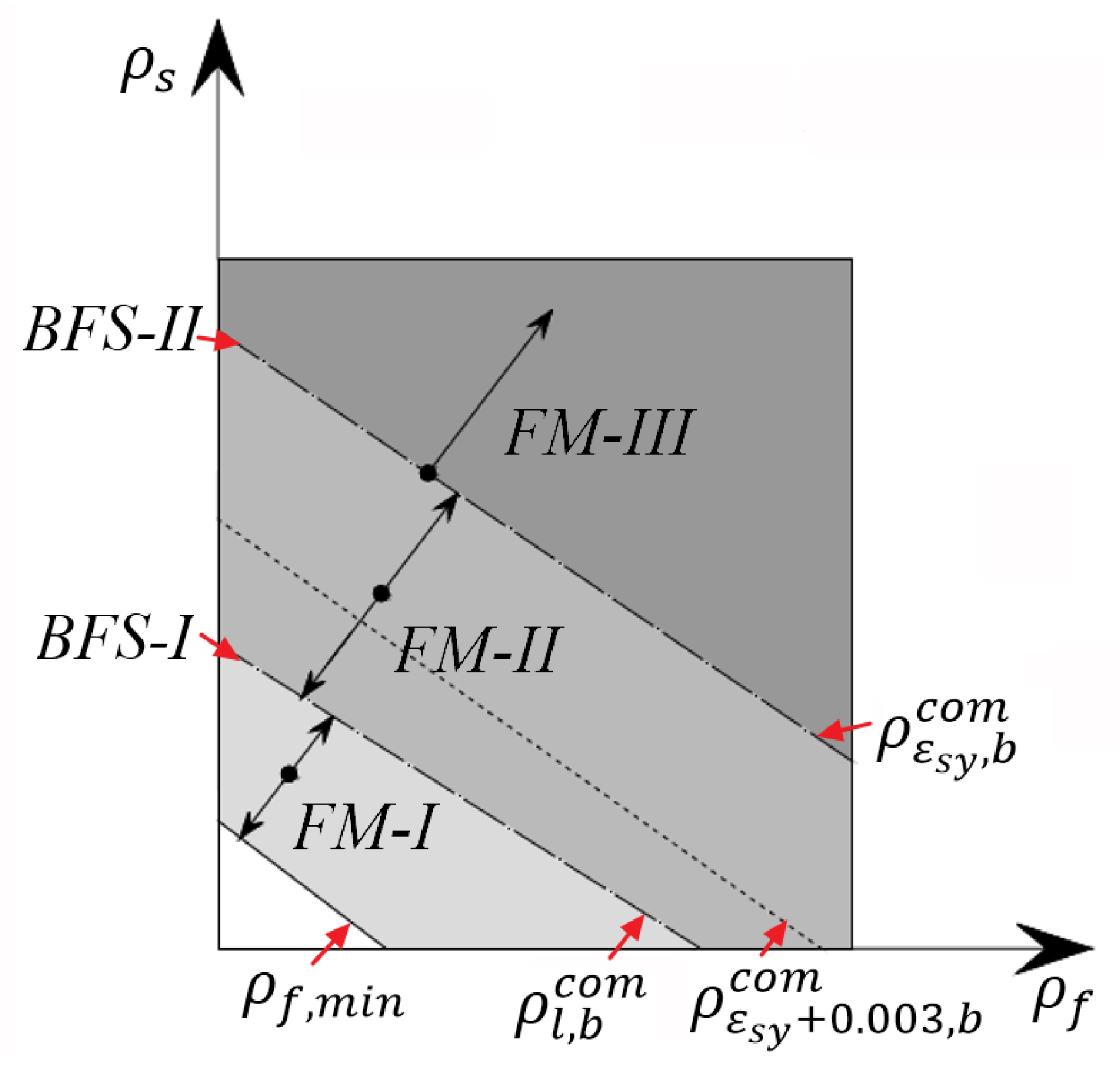
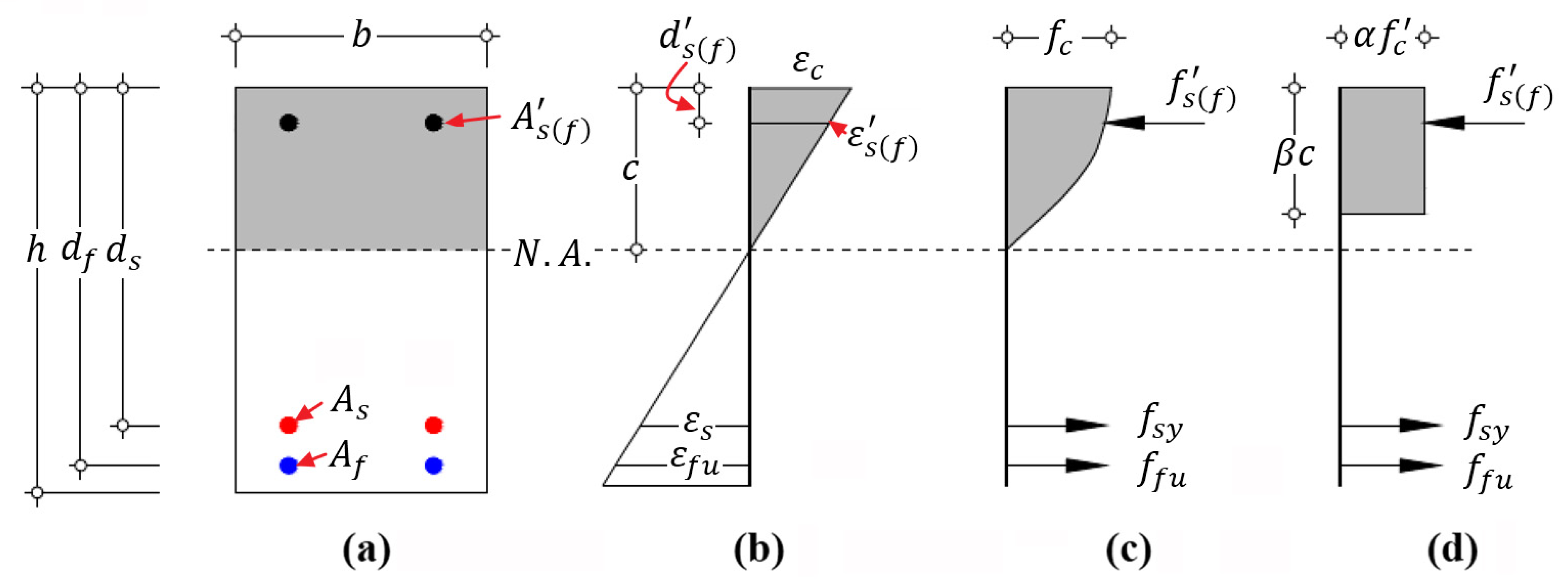


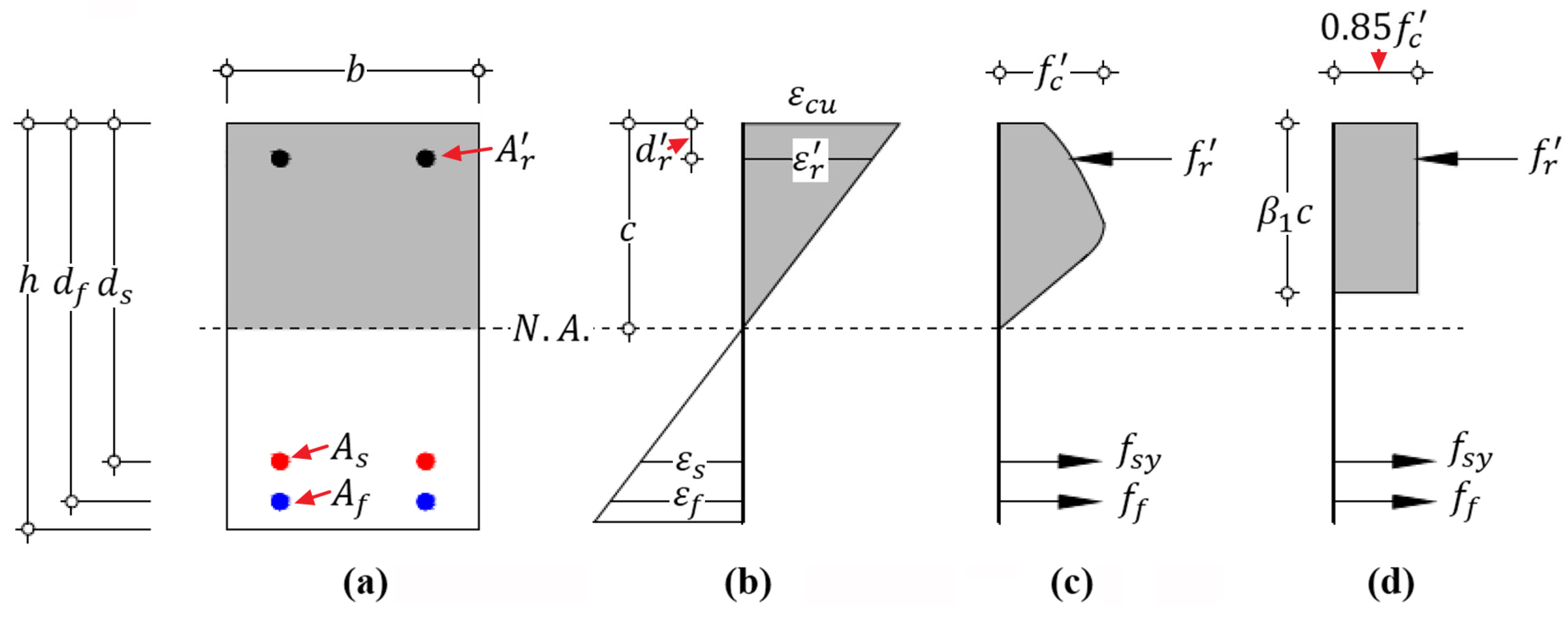
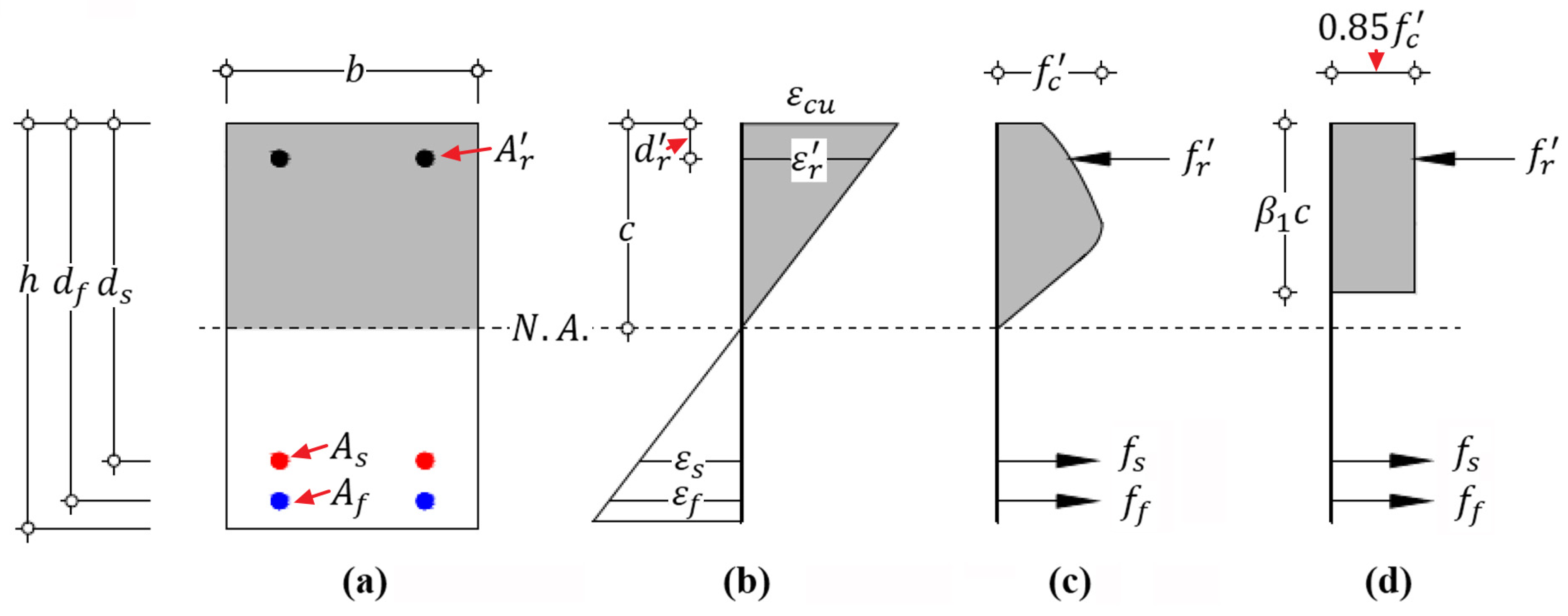
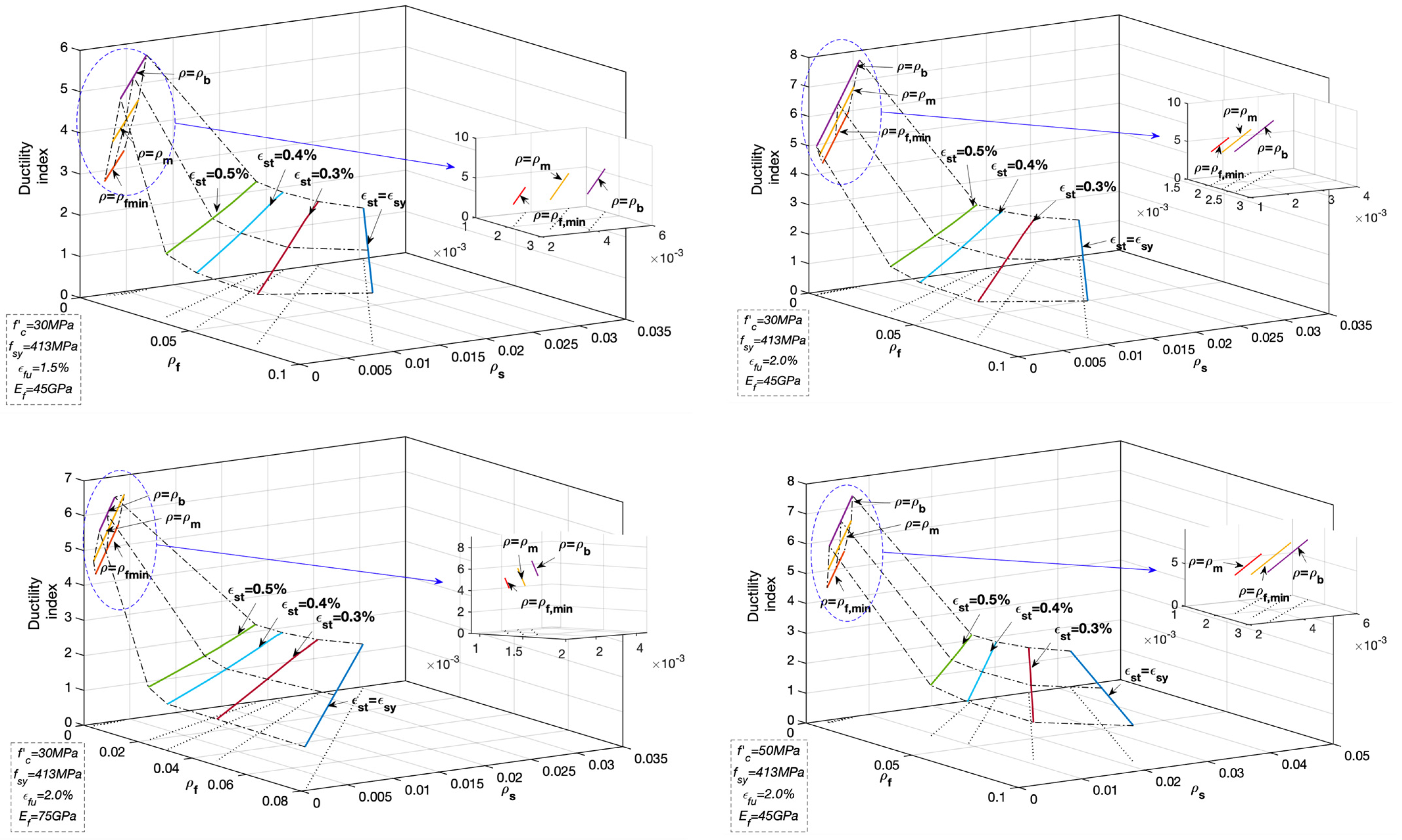
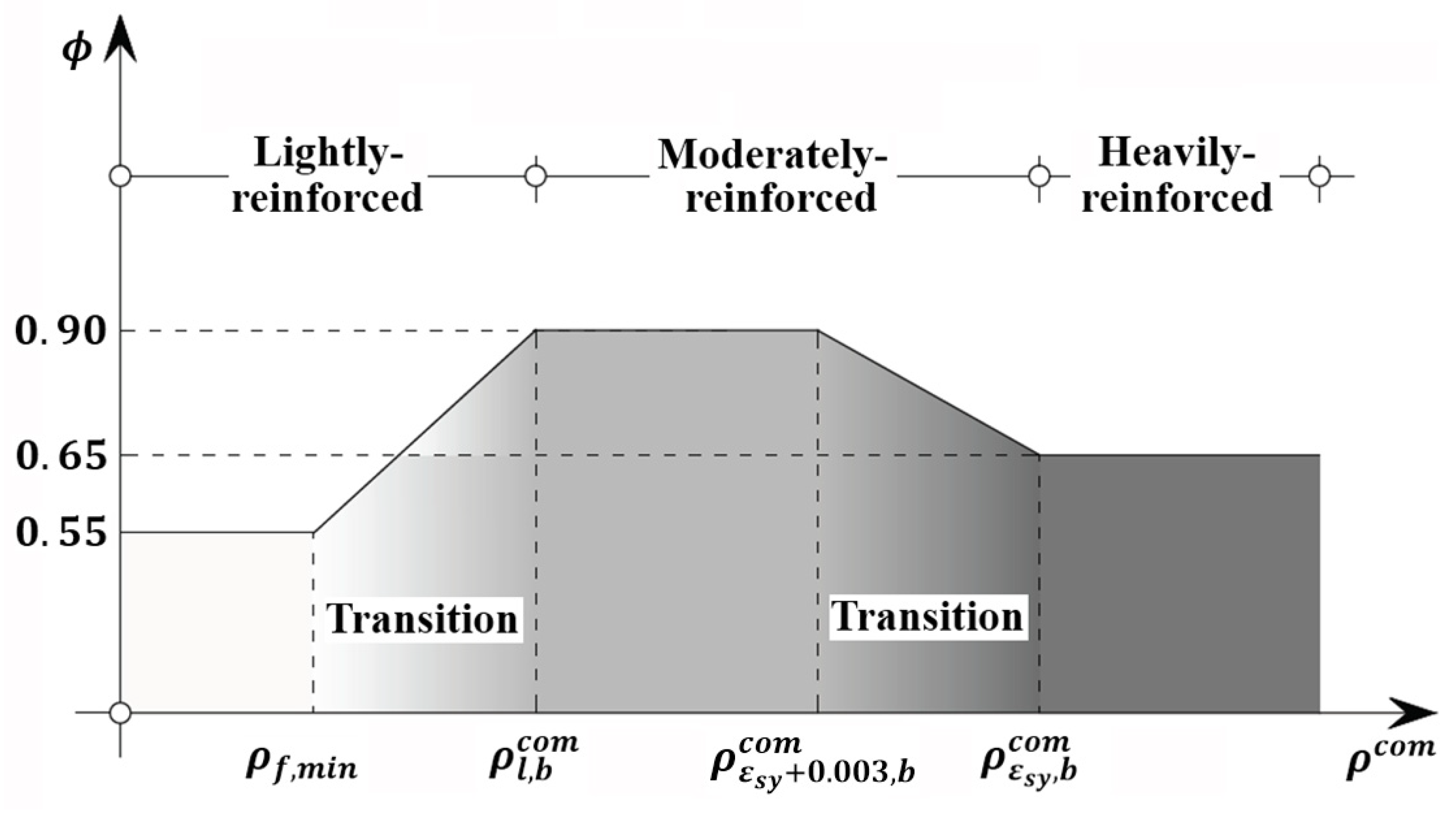
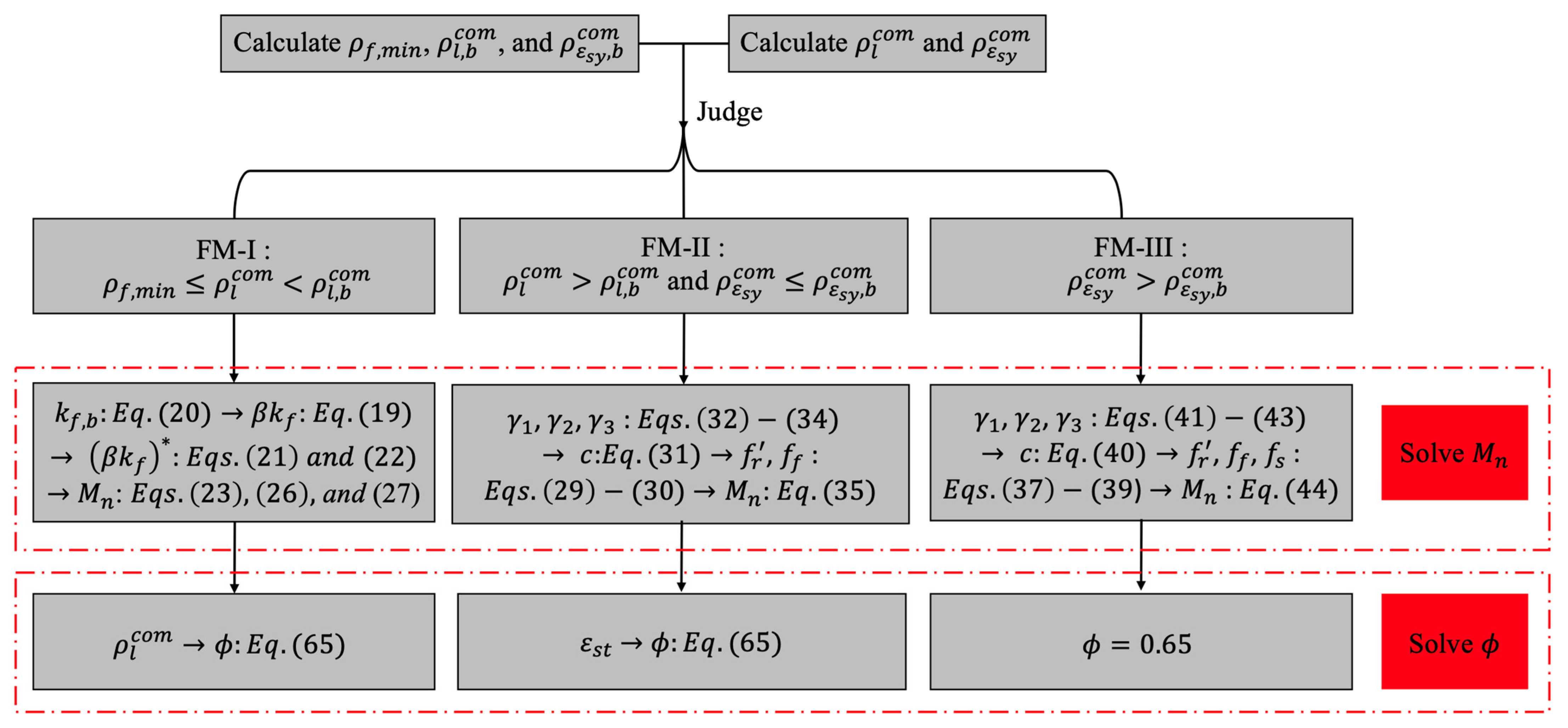
| Parameter | Value |
|---|---|
| Yield strength of steel | 413 and 550 MPa |
| Ultimate tensile strain of FRP | 0.015, 0.02 and 0.025 |
| Compressive strength of concrete | 30, 35, 40, 45 and 50 MPa |
| Modulus of elasticity of FRP | 45, 75 and 145 GPa |
| Reference | Specimen | Geometries | Steel | FRP | Actual Mode | Analytical Mode | (kN·m) | ||||||||||
|---|---|---|---|---|---|---|---|---|---|---|---|---|---|---|---|---|---|
| b (mm) | h (mm) | ||||||||||||||||
| Aiello et al. [1] | A1 | 150 | 200 | 45.7 | 100.48 | 465 | 88.31 | 1674 | 49 | 7.11 | 2.58 | 2.60 | 15.15 | FM-II | FM-II | 21.10 | 0.84 |
| A2 | 150 | 200 | 45.7 | 100.48 | 465 | 157 | 1366 | 50.1 | 9.39 | 3.13 | 3.02 | 14.86 | FM-II | FM-II | 25.64 | 0.90 | |
| A3 | 150 | 200 | 45.7 | 226.08 | 465 | 235.5 | 1366 | 50.1 | 15.63 | 3.16 | 6.09 | 15.07 | FM-II | FM-II | 32.09 | 0.90 | |
| C1 | 150 | 200 | 45.7 | 100.48 | 465 | 88.31 | 1674 | 49 | 6.85 | 2.48 | 2.16 | 15.73 | FM-II | FM-II | 22.27 | 0.89 | |
| Leung et al. [2] | L2 | 150 | 200 | 28.5 | 157 | 460 | 142.6 | 760 | 40.8 | 8.13 | 3.09 | 4.52 | 11.09 | FM-II | FM-II | 15.58 | 0.70 |
| L5 | 150 | 200 | 28.5 | 157 | 460 | 213.9 | 760 | 40.8 | 10.38 | 3.03 | 4.94 | 10.90 | FM-II | FM-II | 17.42 | 0.76 | |
| H2 | 150 | 200 | 48.8 | 157 | 460 | 142.6 | 760 | 40.8 | 8.13 | 4.33 | 4.52 | 15.56 | FM-II | FM-II | 18.76 | 0.89 | |
| H5 | 150 | 200 | 48.8 | 157 | 460 | 213.9 | 760 | 40.8 | 10.38 | 4.25 | 4.94 | 15.30 | FM-II | FM-II | 21.33 | 0.79 | |
| Qu et al. [5] | B3 | 180 | 250 | 28.1 | 226.08 | 363 | 253.23 | 782 | 45 | 6.07 | 3.60 | 2.59 | 12.65 | FM-II | FM-II | 37.86 | 0.99 |
| B4 | 180 | 250 | 28.1 | 200.96 | 336 | 396.91 | 755 | 41 | 7.76 | 3.43 | 2.40 | 13.01 | FM-II | FM-II | 40.67 | 1.03 | |
| B5 | 180 | 250 | 29.2 | 401.92 | 336 | 141.69 | 778 | 37.7 | 5.64 | 3.24 | 3.64 | 13.52 | FM-II | FM-II | 37.69 | 1.04 | |
| B6 | 180 | 250 | 29.2 | 401.92 | 336 | 253.23 | 782 | 45 | 7.41 | 3.74 | 3.89 | 13.52 | FM-II | FM-II | 44.14 | 1.04 | |
| B7 | 180 | 250 | 34.6 | 113.04 | 363 | 141.69 | 778 | 37.7 | 3.26 | 3.46 | 1.28 | 14.02 | FM-I | FM-I | 26.79 | 1.14 | |
| B8 | 180 | 250 | 34.6 | 1205.76 | 336 | 396.91 | 755 | 41 | 17.81 | 4.35 | 12.82 | 14.86 | FM-II | FM-II | 68.52 | 1.08 | |
| Safan [7] | B10/6S | 100 | 200 | 30 | 157 | 530 | 56.6 | 780 | 41 | 7.96 | 4.21 | 6.64 | 10.89 | FM-II | FM-II | 12.66 | 0.90 |
| B10/8S | 100 | 200 | 30 | 157 | 530 | 100.6 | 755 | 39 | 9.37 | 3.99 | 7.01 | 10.71 | FM-II | FM-II | 13.90 | 0.96 | |
| B12/6S | 100 | 200 | 30 | 226 | 470 | 56.6 | 780 | 41 | 9.70 | 4.29 | 8.35 | 11.60 | FM-II | FM-II | 14.13 | 0.95 | |
| B12/8S | 100 | 200 | 30 | 226 | 470 | 100.6 | 755 | 39 | 11.08 | 4.07 | 8.69 | 11.43 | FM-II | FM-II | 15.12 | 0.93 | |
| Araba et al. [16] | SH1 | 200 | 300 | 53.72 | 100.48 | 580 | 169.81 | 1100 | 45.69 | 4.14 | 5.02 | 2.07 | 14.06 | FM-I | FM-I | 49.32 | 0.80 |
| SH2 | 200 | 300 | 56.61 | 401.92 | 580 | 278.97 | 1200 | 55 | 10.46 | 5.05 | 6.70 | 15.09 | FM-II | FM-II | 81.57 | 0.74 | |
| Lau et al. [21] | G03MD1 | 280 | 380 | 41.3 | 981.7 | 336 | 283.5 | 588 | 39.5 | 4.86 | 5.34 | 3.67 | 16.89 | FM-I | FM-I | 146.57 | 1.00 |
| G10T07 | 280 | 380 | 39.8 | 628.3 | 597 | 981.7 | 582 | 38 | 8.73 | 5.05 | 5.07 | 12.94 | FM-II | FM-II | 205.09 | 0.95 | |
| G06T1 | 280 | 380 | 44.6 | 981.7 | 550 | 567.1 | 588 | 39.5 | 8.46 | 5.58 | 6.33 | 14.36 | FM-II | FM-II | 220.43 | 0.97 | |
| Ruan et al. [23] | 2G12-2S12 | 180 | 300 | 30.32 | 226.2 | 517 | 226.2 | 868.22 | 40.06 | 5.77 | 3.16 | 2.95 | 11.49 | FM-II | FM-II | 54.84 | 0.95 |
| 2G16-2S12 | 180 | 300 | 30.32 | 226.2 | 517 | 402.1 | 958.2 | 45.69 | 9.00 | 3.24 | 3.45 | 11.52 | FM-II | FM-II | 65.98 | 1.04 | |
| 2G12-1S16 | 180 | 300 | 30.32 | 201.1 | 540 | 226.2 | 868.22 | 40.06 | 5.61 | 3.17 | 2.83 | 11.25 | FM-II | FM-II | 53.54 | 0.95 | |
| 2G16-1S16 | 180 | 300 | 30.32 | 201.1 | 540 | 402.1 | 958.2 | 45.69 | 8.84 | 3.25 | 3.35 | 11.26 | FM-II | FM-II | 64.82 | 0.97 | |
| 2G12-2S12(D) | 180 | 300 | 30.32 | 226.2 | 517 | 226.2 | 868.22 | 40.06 | 6.13 | 3.36 | 3.52 | 11.11 | FM-II | FM-II | 50.51 | 0.94 | |
| 2G16-2S12(D) | 180 | 300 | 30.32 | 226.2 | 517 | 402.1 | 958.2 | 45.69 | 9.40 | 3.38 | 4.28 | 10.82 | FM-II | FM-II | 61.18 | 1.21 | |
| Average | - | - | - | - | - | - | - | - | - | - | - | - | - | - | - | - | 0.94 |
| Standard deviation | - | - | - | - | - | - | - | - | - | - | - | - | - | - | - | - | 12% |
Publisher’s Note: MDPI stays neutral with regard to jurisdictional claims in published maps and institutional affiliations. |
© 2021 by the authors. Licensee MDPI, Basel, Switzerland. This article is an open access article distributed under the terms and conditions of the Creative Commons Attribution (CC BY) license (https://creativecommons.org/licenses/by/4.0/).
Share and Cite
Zhou, B.; Wu, R.-Y.; Liu, Y.; Zhang, X.; Yin, S. Flexural Strength Design of Hybrid FRP-Steel Reinforced Concrete Beams. Materials 2021, 14, 6400. https://doi.org/10.3390/ma14216400
Zhou B, Wu R-Y, Liu Y, Zhang X, Yin S. Flexural Strength Design of Hybrid FRP-Steel Reinforced Concrete Beams. Materials. 2021; 14(21):6400. https://doi.org/10.3390/ma14216400
Chicago/Turabian StyleZhou, Binbin, Ruo-Yang Wu, Yangqing Liu, Xiaohui Zhang, and Shiping Yin. 2021. "Flexural Strength Design of Hybrid FRP-Steel Reinforced Concrete Beams" Materials 14, no. 21: 6400. https://doi.org/10.3390/ma14216400
APA StyleZhou, B., Wu, R.-Y., Liu, Y., Zhang, X., & Yin, S. (2021). Flexural Strength Design of Hybrid FRP-Steel Reinforced Concrete Beams. Materials, 14(21), 6400. https://doi.org/10.3390/ma14216400







